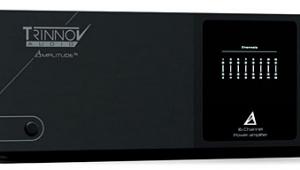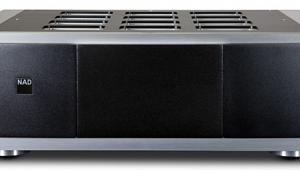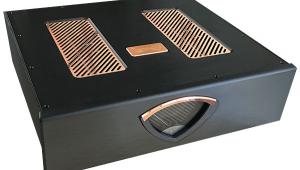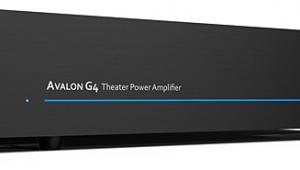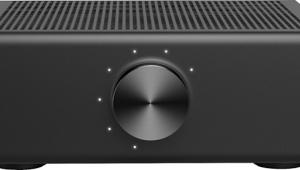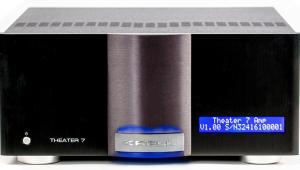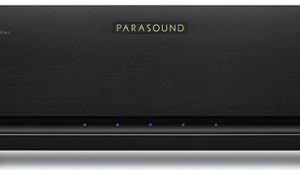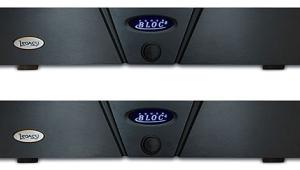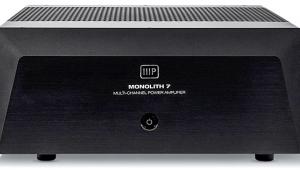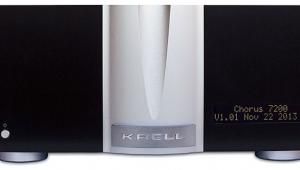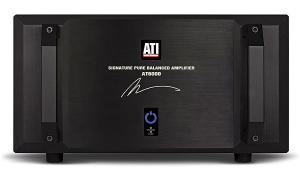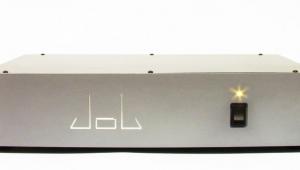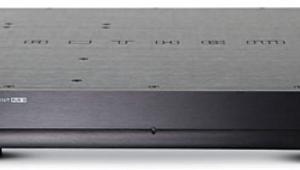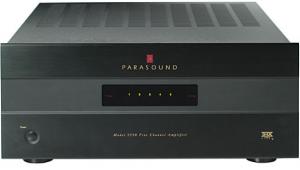Bryston Powerpack 300 Power Amplifier
 Many consumer-electronics pundits may deny it, but sound matters in a high-end home theater. How much? I would hazard to say that the sonic character of a home theater is even more important than its picture quality. To give you an example, let me regale you with a tale from my most recent family vacation aboard the Grand Princess cruise ship. The Grand Princess shows a movie each evening "under the stars" on the top deck using an impressively large, exceedingly bad LED screen (such as you see outdoors in Las Vegas) that turned blacks purple and skin tones ruddy orange, and it had the resolution of a cheap 13-inch monitor. Think of a poorly set-up, first-generation Kloss Nova-beam video projector, circa late 1970s. But the Grand Princess' movie sound system ruled. With an impressive configuration of phase-array sound-reinforcement speakers, the sonics were articulate and dynamically impressive. The final result made watching movies, despite the abysmal picture, an involving experience. Trust me—sound matters, big time.
Many consumer-electronics pundits may deny it, but sound matters in a high-end home theater. How much? I would hazard to say that the sonic character of a home theater is even more important than its picture quality. To give you an example, let me regale you with a tale from my most recent family vacation aboard the Grand Princess cruise ship. The Grand Princess shows a movie each evening "under the stars" on the top deck using an impressively large, exceedingly bad LED screen (such as you see outdoors in Las Vegas) that turned blacks purple and skin tones ruddy orange, and it had the resolution of a cheap 13-inch monitor. Think of a poorly set-up, first-generation Kloss Nova-beam video projector, circa late 1970s. But the Grand Princess' movie sound system ruled. With an impressive configuration of phase-array sound-reinforcement speakers, the sonics were articulate and dynamically impressive. The final result made watching movies, despite the abysmal picture, an involving experience. Trust me—sound matters, big time.
This roundabout introduction brings me to the latest offering from Bryston Ltd. Perhaps better known among audiophiles and sound professionals than videophiles, Bryston has been making bulletproof electronics for close to 30 years. Their products are so well built that Bryston offers the only 20-year unconditional warrantee in the industry. It covers not only the original owner, but subsequent owners as well. Bryston has even been known to occasionally repair an out-of-warranty product for free.
One Is Good
Three years ago, I reviewed the Bryston Powerpack 120 monoblock amplifiers in Stereophile Guide to Home Theater. Since then, these compact 10-pound beasties have seen duty in almost every imaginable capacity, from the front channels in my main home theater system to on-location sound reinforcement amps for my bluegrass band. They have proven to be indestructible, flexible, and fine-sounding 120-watt amplifiers. My main complaint with the Bryston Powerpack 120 is that it only produces 120 watts. Sometimes I wish I had a bit more power. Enter the new Bryston Powerpack 300.
The Powerpack 300's compact package belies its brawn. Although rated at 300 watts into 8ohm and 500 watts into 4ohm, all the amplifiers sent for review actually put out more juice (up to 343 watts into 8ohm as indicated by the individual test-result sheets that accompany each amp). Designed so it can be bolted to the back of a speaker, tucked into an equipment closet, or even placed between the studs of a wall behind an access panel, the top surface of the Powerpack 300 is comprised mainly of heat sinks. Underneath the heat sinks are input connectors for unbalanced (RCA) and balanced operation. (The balanced inputs are the increasingly common combination connectors that can accept XLR or 1/4-inch plugs.) Rounding out the connection complement are a pair of UL/European Union-approved speaker connectors, a standard IEC AC connector, and a 12-volt trigger connection. A three-way power switch has local (on), off, and 12-volt remote-sensor settings. Absent is the ground-lift switch I've grown to appreciate on the Bryston Powerpack 120. Many times, this little switch has banished hum problems in my home theater and in the field. Instead, the Powerpack 300 has newer circuitry that senses differences between ground voltages and compensates for up to 1.5-volt variations, thereby eliminating ground loop hum automatically. This worked effectively in my tests, though being somewhat old-school, I would prefer manual control over this function.
The circuit topologies of all Bryston amplifiers have a certain family resemblance. Over the years, Bryston developed a two-part philosophy that "simple is superior to complex" and "never overstressing a component insures it will seldom fail." The Powerpack 300's circuit is a practical example of that philosophy. Even though the Powerpack 300 uses a balanced-differential design throughout, it has only three separate gain stages. The first, called the buffer, balances the single-ended inputs and delivers the proper internal impedances. It then sends the signal to the voltage-amplification stage. Unlike many amplifiers, which rely on this second stage to do all the signal amplification, the Powerpack 300's final stage, which supplies the current, shares some of the amplification duties. With this approach, the second stage doesn't have to run "full rail" during dynamic peaks, regardless of the source's demands.
Like most of Bryston's latest amplifiers, the Powerpack 300 utilizes PNP (positive-negative-positive) and NPN (negative-positive-negative) complementary bipolar output transistors in carefully matched pairs on each half of the output stage. This complementary configuration neutralizes the non-linearities of the individual output devices. Bryston calls this proprietary circuit a "quad-complementary" configuration. Not only does it reduce the input capacitance of the output devices by a factor of four, but the output devices' transfer functions meet seamlessly at the zero-crossing point, resulting in virtually zero crossover distortion.
The tricky part of Bryston's quad-complementary circuit is that it requires precisely matched output transistors. Both the PNP and NPN devices must have similar (but inverted) gain and impedance values to work together. Once the parts have been selected, the circuit has several sensors to monitor the bias of each one so they can remain tightly correlated. According to Bryston's technical papers, "In our opinion, the slight increases in required engineering investigation are far outweighed by the overall improvement in wide-band accuracy of this type of output section. The result is that almost mythical best-of-all-worlds, where, with no substantial increase in cost or parts-complexity, a truly better design is possible, with superior performance and listening quality."
- Log in or register to post comments
